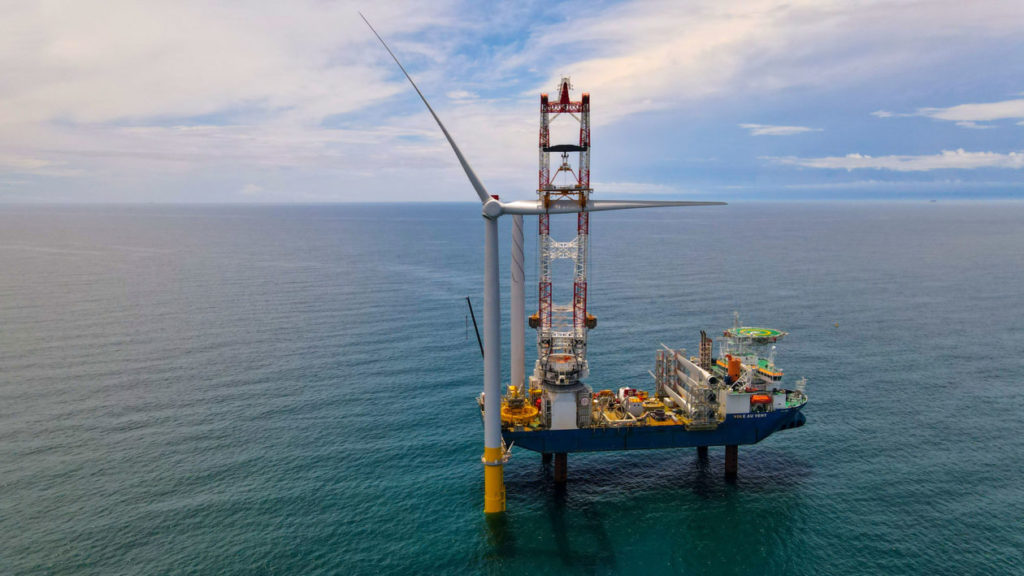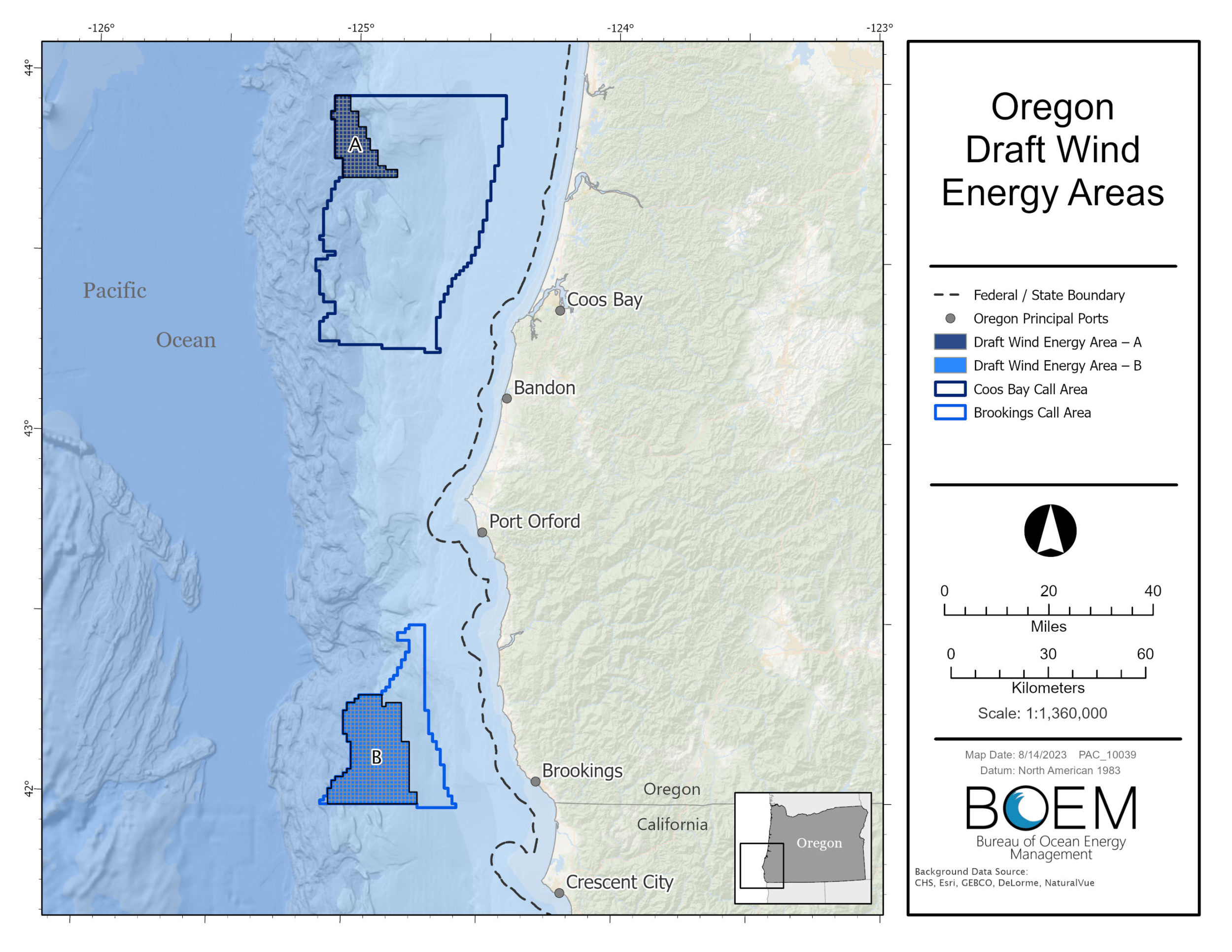
By DANA TIMS/YachatsNews
Most of Oregon’s congressional delegation is hailing what they call a 60-day pause in federal efforts to develop floating offshore wind-energy platforms off the southern Oregon coast.
Their comments, made in a letter to the director of the federal agency overseeing wind-energy planning, came after the government identified two draft “wind energy areas” off Coos Bay and Brookings.
The two so-called “call areas” cover approximately 219,568 acres, with their closest points ranging from about 18 to 32 miles off the coast.
“Deploying clean energy is imperative to move our country forward and meet our climate goals,” stated the letter, which was signed by Democratic senators Ron Wyden and Jeff Merkley, and Democratic representatives Val Hoyle and Suzanne Bonamici. “But it’s also important to have robust community engagement throughout the entire process to ensure any project is done responsibility.”
The federal Bureau of Ocean Energy Management announced the commencement of a 60-day public comment period, starting Tuesday, for groups, tribes and individuals to weigh in on the proposed call areas. Comments will be accepted online and by mail.
Three public, in-person meetings will also be held in Oregon coastal communities to gather further comments.
BOEM officials, in a news release, said they identified the two draft call areas after a “comprehensive process that involved outreach to potentially impacted stakeholders and ocean users.”
Elizabeth Klein, the agency’s director, said the 60-day public comment period came at the request of Oregon Gov. Tina Kotek and other state officials.
“We look forward to working with the state to help us finalize offshore areas that have strong resource potential and the fewest environmental and user conflicts,” she said in a statement.
The fast pace of the program has drawn criticism from a number of groups ever since the Biden administration announced two years ago plans to deploy 30 gigawatts of offshore wind energy capacity by 2030. That’s enough to power 10 million homes.
In Lincoln County alone, groups asking the federal government to either slow or augment plans to build wind-energy farms off the coast include Lincoln County commissioners, the Port of Toledo, the Newport City Council and the legislative Coastal Caucus.
Not heeded, so far, has been a call by an influential group charged with helping manage West Coast fisheries. That request came in March, when the Pacific Fishery Management Council asked the federal government to completely start over with its siting plans.
A motion calling for the process to be started anew passed unanimously with abstentions cast by the state representatives for Oregon, Washington and California.

Third site dropped
The two areas are 20 or more miles from land, collectively encompass about 344 square miles of ocean and could host enough floating wind turbines to generate 2.6 gigawatts of electricity, enough to power about 195,000 homes.
That would get Oregon closer to a goal passed by the 2021 Legislature to generate at least 3 gigawatts of electricity from offshore wind by 2030, part of the state’s larger climate strategy to reduce greenhouse gas emissions 90 percent by 2050.
Federal officials dropped a third wind energy area near Bandon that they were considering after officials did further research on the impact to the commercial fishing industry and to sensitive marine habitats.
Following public comment, officials could update the plans, and the bureau will prepare to host an auction to lease the sites to companies interested in developing them, potentially by the end of 2023.
A similar auction in California in 2022 brought in $757 million in winning bids from three multinational companies and one domestic company developing floating wind farms.
President Joe Biden has pledged to develop at least 15 gigawatts of floating offshore wind by 2035.
- The Oregon Capital Chronicle contributed to this report.



This is going to hurt the birds in this area.
I moved to Gold Beach because of the ocean views. Looking at those monstrous wind machines would totally ruin our view, for us and visitors to our beautiful city and Rogue River. Place them far north to the beach that Portlanders use. They love this kind of stuff.
Just like they destroyed the views of the Columbia River Gorge. And you hear nothing from the animal rights groups and environmentalists about the number of birds killed annually by them, some which have been identified as endangered
If we keep using fossil fuels for energy, the ocean waters will warm even faster. This warming is having devastating impacts on marine life now. What will the fishing Industry do when there are so few fish to catch, it’s not worth the fuel to go out fishing? It’s time for drastic measures to save our marine life from extinction.
It won’t be easy to see a windmill 20 miles out, and the anchoring cables are safer for marine life than nets.
Over the past few years, all I have heard is ridiculous objections to offshore wind turbines. If the fishing industry is going to continue to whine about these things, then it needs to present some actual evidence that they would do harm. So far I’ve heard nothing but hot air. The New York Times reported a while back that fishing industry opposition to wind farms off the New England coast was actually being financed by the oil industry. We need to keep our eyes open to make sure that isn’t happening here.
The biggest commercially available offshore wind turbine is made in China, and has a capacity of 16 megawatts. General Electric makes one with a capacity of 14 megawatts. So assuming each turbine has a capacity of 15 megawatts, a 2.6 gigawatt project would require 173 turbines. Offshore wind turbine towers are typically 350 to 500 feet tall (not counting the blades).
Standing at sea level and looking at the project 20 miles out at sea, the curvature of the earth would obscure only the lower 200 feet of the towers, leaving most of top of the tower and the turbine blades visible above the horizon. At night, navigation lights atop those 173 towers will be visible. Only at 35 miles out would they not be visible from shore.
So? Seems like a much better alternative than to continue to fry the Earth with fossil fuel emissions.